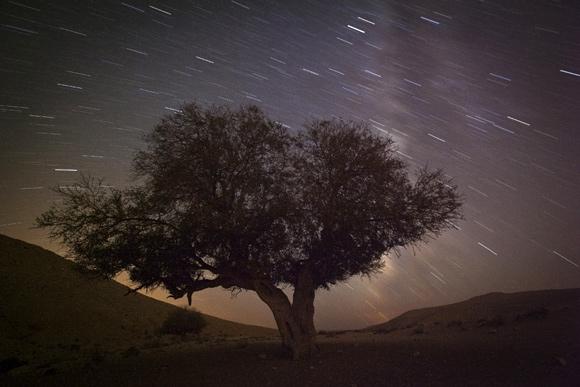 | « Back to article | Print this article |
PIX: Perseid meteor shower puts on a dazzling light show
The annual Perseid meteor shower lit up the night sky providing a dazzling light show for stargazers. The Perseid meteor shower has been observed for about 2000 years.
The shower is visible from mid-July each year, with the peak in activity being between August 9 and 14, depending on the particular location of the stream.
During the peak, the rate of meteors reaches 60 or more per hour. They can be seen all across the sky, but because of the path of Swift-Tuttle's orbit, Perseids are primarily visible in the northern.
Click NEXT to see more PHOTOS...
PIX: Perseid meteor shower puts on a dazzling light show
A man (bottom) and a woman observe meteors streaking past stars and the moon with a telescope in the night sky over El Torcal nature park reserve in the southern Spanish town of Antequera, near Malaga.
The Perseid meteor shower is sparked every August when the Earth passes through a stream of space debris left by comet Swift-Tuttle.
Click NEXT to see more PHOTOS...
PIX: Perseid meteor shower puts on a dazzling light show
People watch the annual Perseid meteor shower in the southern town of Mitzpe Ramon.
Click NEXT to see more PHOTOS...
PIX: Perseid meteor shower puts on a dazzling light show
A meteor (top, R) streaks past stars in the night sky above medieval tombstones in Radmilje near Stolac.
Click NEXT to see more PHOTOS...
PIX: Perseid meteor shower puts on a dazzling light show
People wake up after observing meteors streaking past stars in the night sky over El Torcal nature park reserve in the southern Spanish town of Antequera.
Click NEXT to see more PHOTOS...
PIX: Perseid meteor shower puts on a dazzling light show
A meteor (top C) streaks past stars in the night sky above medieval tombstones in Radmilje near Stolac.
Click NEXT to see more PHOTOS...
PIX: Perseid meteor shower puts on a dazzling light show
A meteor (top) streaks past stars in the night sky above Lake Geneva and the Mont-Blanc, at the Mont-Tendre near Montricher in the Jura, north of Geneva.
Click NEXT to see more PHOTOS...
PIX: Perseid meteor shower puts on a dazzling light show
A meteor (top, R) streaks past stars in the night sky above Lake Geneva and the Mont-Blancl, at the Mont-Tendre near Montricher in the Jura, north of Geneva.
TOP photo features of the week
Click on MORE to see another set of PHOTO features...








